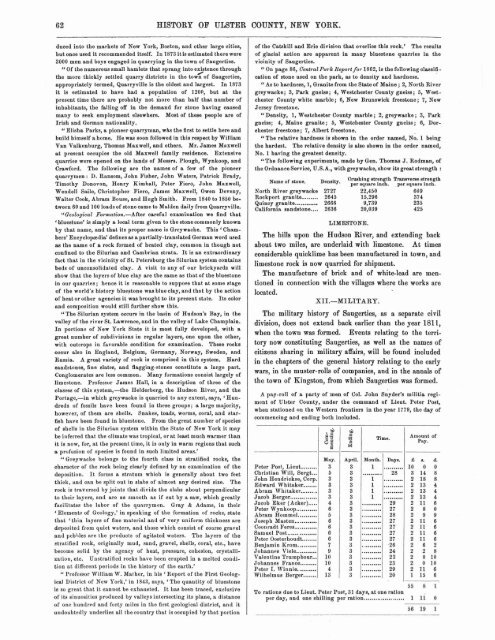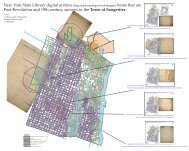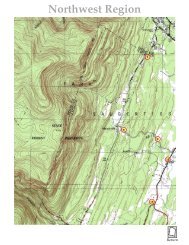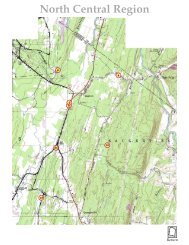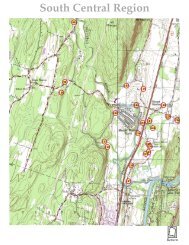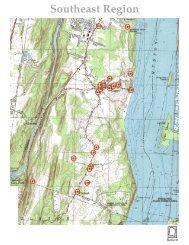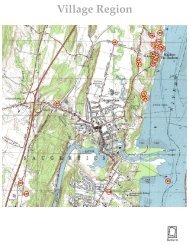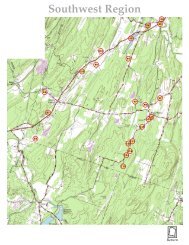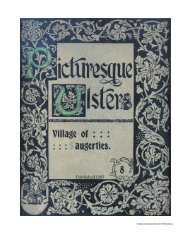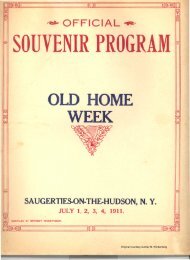1880 History of Ulster County New York - Saugerties Section
The 1880 History of Ulster County compiled by Nathaniel Bartlet Sylvester was one of a number of advanced subscription vanity publications centered on county-based histories produced by Sylvester. The information basically duplicates the gazettes, commercial white papers and census records of the day and utilized the writing skills of reporters in the local press who gathered their research directly from the wealthy businessmen that paid the subscription. Saugerties had a wealth of information already collected from The Pearl published five years earlier and has the most pages of any town in this volume. This history is the predecessor to later studies by Benjamin Myer Brink and Alfonso Clearwater as well as Marius Schoonmaker after the turn of the century. When all of these are taken together and discounted for the lack of accurate translation of the earliest Dutch and German documents the result is a history of the Kingston territory of the mid Hudson valley generally referred to as the Kingston Commons. Interest in this larger history is the natural outcome of a reading of this history of Saugerties.
The 1880 History of Ulster County compiled by Nathaniel Bartlet Sylvester was one of a number of advanced subscription vanity publications centered on county-based histories produced by Sylvester. The information basically duplicates the gazettes, commercial white papers and census records of the day and utilized the writing skills of reporters in the local press who gathered their research directly from the wealthy businessmen that paid the subscription. Saugerties had a wealth of information already collected from The Pearl published five years earlier and has the most pages of any town in this volume.
This history is the predecessor to later studies by Benjamin Myer Brink and Alfonso Clearwater as well as Marius Schoonmaker after the turn of the century. When all of these are taken together and discounted for the lack of accurate translation of the earliest Dutch and German documents the result is a history of the Kingston territory of the mid Hudson valley generally referred to as the Kingston Commons.
Interest in this larger history is the natural outcome of a reading of this history of Saugerties.
Create successful ePaper yourself
Turn your PDF publications into a flip-book with our unique Google optimized e-Paper software.
62 HISTORY OF ULSTER COUNTY, NEW YORK.<br />
dnced into the markets <strong>of</strong> <strong>New</strong> <strong>York</strong>, Boston, and other large cities,<br />
but once used it recommended itself. In 1873 it is estimnted there were<br />
3000 men and boys engaged in quarrying in the town <strong>of</strong> <strong>Saugerties</strong>.<br />
"Of the numerous small hamlets that sprang into existence through<br />
#<br />
the more thickly settled quarry districts in the town <strong>of</strong> <strong>Saugerties</strong>,<br />
appropriately termed, Quarryville is the oldest and largest. In 1873<br />
it is estimated to have had a population <strong>of</strong> 1200, but at the<br />
present time there are probably not more than half that number <strong>of</strong><br />
inhabitants, the falling <strong>of</strong>f in the demand for stone having caused<br />
many to seek employment elsewhere. Most <strong>of</strong> them people are <strong>of</strong><br />
Irish and German nationality.<br />
'' Elisha Parks, s pioneer quarryman, wks the first to settle here and<br />
build himself a home. He was soon followed in this respect by William<br />
Van Valkenburg, Thomas Maxwell, and others. Mr. James Maxwell<br />
at prescnt occupies the old Maxwell family residence. Extensive<br />
quarries were opened on the lands <strong>of</strong> Messrs. Plough, Wynkoop, and<br />
Crawford. The following are the names <strong>of</strong> a few <strong>of</strong> the pioneer<br />
quarrymen : D. Ransom, John Fisher, John Waters, Patrick Brady,<br />
Timothy Donovnn, Henry Kimball, Peter Fiero, John Maxwell,<br />
Wendell Saile, Christopher Fiero, James Maxwell, Owen Deveny,<br />
Walter Cook, Abram Bouse, and Hugh Smith. From 1840 to 1850 between<br />
60 and 100 loads <strong>of</strong> stone came to Malden daily from Quarryville.<br />
"Geological Formatian.-After careful examination we find thnt<br />
'bluestone' is simply a local term given to the stonecommonly known<br />
by that name, and that its proper name is Qreywacke. This 'Chambers'<br />
Encyclopmdia' defines as a partially-translated German word used<br />
aa the name <strong>of</strong> a rock formed <strong>of</strong> heated clay, common in though not<br />
confined to the Silurian and Cambrian stratn. It is an extraordinary<br />
fact that in the vicinity <strong>of</strong> St. Petersburg the Silurian system contains<br />
beds <strong>of</strong> unconsolidnted clay. A visit to any <strong>of</strong> our brickyards will<br />
show that the layers <strong>of</strong> blue clay are the same as that<strong>of</strong> the bluestone<br />
in our quarries; hence it is reasonable to suppose thnt at some stage<br />
<strong>of</strong> the world's history bluestone was blue clay, and thnt by the action<br />
<strong>of</strong> heat or other ngencies it was brought to its present stste. Its color<br />
and composition would still further show this.<br />
"The Silurian system occurs in the basin <strong>of</strong> Hudson's Bay, in the<br />
valley <strong>of</strong> the river St. Lawrence, and in the valley <strong>of</strong> Lake Champlain.<br />
In portions <strong>of</strong> <strong>New</strong> <strong>York</strong> State it is most fully developed, with a<br />
great number <strong>of</strong> subdivisions in regular layers, one upon the other,<br />
with outcrops in favorable condition for examination. These rocks<br />
occur also in England, Belgium, Germany, Norway, Sweden, and<br />
Russia A great variety <strong>of</strong> rock is comprised in this system. Hard<br />
sandstones, fine slates, and Bagging-stones constitute a large part.<br />
Conglomerates are less common. Many formations consist largely <strong>of</strong><br />
limestone. Pr<strong>of</strong>essor James Hall, in a description <strong>of</strong> three <strong>of</strong> the<br />
classes <strong>of</strong> this system,-the Helderberg, the Hudson River, and the<br />
Portage,-in which greywacke is quarried to any extent, says, 'Hundreds<br />
<strong>of</strong> fossils have been found in these groups; a large majority,<br />
however, <strong>of</strong> them nre shells. Snakes, toads, worms, coral, and starfish<br />
have been found in bluestone. From the great number <strong>of</strong> species<br />
<strong>of</strong> shells in the Silurian system within the State <strong>of</strong> <strong>New</strong> <strong>York</strong> it may<br />
be inferred that the climate was tropical, or at least much warmer than<br />
it is now, for, at the present time, it is only in warm regions that such<br />
a pr<strong>of</strong>usion <strong>of</strong> species is found in such limited areas.'<br />
"Greywacke belongs to the fourth class in stratified rocks, the<br />
chnracter <strong>of</strong> the rock being clearly defined by an examination <strong>of</strong> the<br />
deposition. It forms a strntum which i~ generally about two feet<br />
thick, and can be split out in slabs <strong>of</strong> almost any desired size. The<br />
rock is travereed by joints that divide the slabs about perpendicular<br />
to their layers, and are as slnooth as if cut by a saw, which greatly<br />
facilitates the labor <strong>of</strong> the qunrrymen. Gray & Adams, in their<br />
'Elements <strong>of</strong> Geology,' in spenking <strong>of</strong> the formation <strong>of</strong> rocks, state<br />
that 'thin layers <strong>of</strong> fine material and <strong>of</strong> very uniform thickness are<br />
dqosited from quiet waters, and those which consist <strong>of</strong> coarse gravel<br />
and pebhles are the products <strong>of</strong> agitated waters. The layers <strong>of</strong> the<br />
etrntified rock, originally mud, sand, gravel, shells, coral, etc., have<br />
become solid by the agency <strong>of</strong> bent, pressure, cohesion, crystallization,<br />
eta. Unstratificd rocks have been erupted in a melted condition<br />
at different periods in the history <strong>of</strong> the earth.'<br />
" Pr<strong>of</strong>essor Willinm W. Mather, in his 'Report <strong>of</strong> the First Qeological<br />
District <strong>of</strong> <strong>New</strong> <strong>York</strong>,' in 1843, says, 'The quantity <strong>of</strong> bluestone<br />
is so grent thnt it cannot be exhausted. It has been traced, exelusive<br />
<strong>of</strong> its sinuosities produced by valleys intersecting its plane, a distance<br />
<strong>of</strong> one hundred and forty miles in the first geological district, and it<br />
undoubtedly underlies nll thecountry that is occnpied hy thnt portion<br />
<strong>of</strong> the Catskill and Erie division that overlies this rock.' The results<br />
<strong>of</strong> glacial action are apparent in many bluestone quarries in the<br />
vioinity <strong>of</strong> <strong>Saugerties</strong>.<br />
'6 On page 86, Central Purk Neport for 1862, is the following classification<br />
<strong>of</strong> stone used on the park, as to density and hardness.<br />
'cAs to hardness, 1, Granite from the State <strong>of</strong> Maine ; 2, North River<br />
gmywacke; 3, Park gneiss; 4, Westahester <strong>County</strong> gneiss; 5, Westcheater<br />
<strong>County</strong> white marble; 6, <strong>New</strong> Brnnswick freestone; 7, <strong>New</strong><br />
Jersey freestone.<br />
"Density, 1, Westchester <strong>County</strong> marble; 2, greywacke; 3, Park<br />
gneiss; 4, Maine granite; 5, Westcheater <strong>County</strong> gneiss; 6, Dorohester<br />
freestone; 7, Albert freestone.<br />
"The relative hardness is shown in the order named, No. 1 being<br />
the hardest. The relative density is also shown in the order named,<br />
No. 1 having the greatest density.<br />
"The following experiments, made by Gen. Thomaa J. Rodman, <strong>of</strong><br />
the OrdnaneeService, U.S.A., with greywacke, show its great strength :<br />
Name <strong>of</strong> stone. Density. Cm8hing strength Ttunnverw strength<br />
per sqnare inch. per aquare inch.<br />
North River greywacke 2727 22,450 609<br />
Rockport granite 2645 15.296 374<br />
Quincy granite ............ 2666 9,739 235<br />
California sandstone .... 2636 20,039 425<br />
LIMESTONE.<br />
The hills upon the Hudson River, and extending back<br />
about two miles, are underlaid with limestone. At times<br />
considerable quicklime bas been manufactured in town, and<br />
limestone rock is now quarried for shipment.<br />
The manufacture <strong>of</strong> brick and <strong>of</strong> white-lead are mentioned<br />
in connection with the villages where the works are<br />
located.<br />
XI1.-MILITARY.<br />
The military history <strong>of</strong> <strong>Saugerties</strong>, as a separate civil<br />
division, does not extend back earlier than the year 1811,<br />
when the town was formed. Events relating to the territory<br />
now constituting <strong>Saugerties</strong>, as well as the names <strong>of</strong><br />
citizens sharing in military affairs, will be found included<br />
in the chapters <strong>of</strong> the general history relating to the early<br />
wars, in the muster-rolls <strong>of</strong> companies, and in the annals <strong>of</strong><br />
tho town <strong>of</strong> Kingston, from which <strong>Saugerties</strong> was formed.<br />
A pny-roll <strong>of</strong> a party <strong>of</strong> men <strong>of</strong> Col. John Snyder's militia regiment<br />
<strong>of</strong> <strong>Ulster</strong> <strong>County</strong>, under the command <strong>of</strong> Lieut. Peter Post,<br />
when stationed nu the Western frontiers in the year 1779, the day <strong>of</strong><br />
commencing and ending both included.<br />
Peter Post, Licnt ........<br />
Christian Will, Sergt ...<br />
John Hendrickse, Corp.<br />
Edward Whitnker .......<br />
Abrnm W hitaker .........<br />
Jacob Berger ..............<br />
Jacob Eker (Acker) Peter Wynkoop ...........<br />
Abram Hommcl ..........<br />
Joseph Masten ............<br />
Coon radt Fercs ............<br />
Samuel Post ...............<br />
Peter Oosterhoudt ........<br />
Benjamin Krom ..........<br />
Johannes Vielc ...........<br />
Valentine Trumpbour ...<br />
Joliannes France .........<br />
Peter I. Winnie ..........<br />
Wilhelmus Berger ....... 1<br />
May.<br />
3<br />
5<br />
3<br />
3<br />
3<br />
3<br />
4<br />
6<br />
5<br />
6<br />
6<br />
6<br />
6<br />
7<br />
9<br />
10<br />
10<br />
4<br />
13<br />
April.<br />
3<br />
3<br />
3<br />
3<br />
3<br />
3<br />
3<br />
3<br />
3<br />
3<br />
3<br />
3<br />
3<br />
3<br />
3<br />
3<br />
3<br />
3<br />
3<br />
Month.<br />
1<br />
Days.<br />
..........<br />
.......... 28<br />
1 ..........<br />
1 ..........<br />
1 ..........<br />
1<br />
..........<br />
..........<br />
29<br />
..........<br />
.......... 27<br />
28<br />
..........<br />
.......... 27<br />
27<br />
..........<br />
.......... 27<br />
27<br />
..........<br />
.......... .26<br />
24<br />
.......... 23<br />
.......... 23<br />
.......... 29<br />
.......... 1 20<br />
Amount <strong>of</strong><br />
S 8. d.<br />
10 0 0<br />
3 14 8<br />
2 18 8<br />
2 1 3 4<br />
2 1 3 4<br />
2 1 3 4<br />
2 11 6<br />
2 8 0<br />
2 9 9<br />
2 11 6<br />
2 11 6<br />
2 11 6<br />
211 6<br />
2 6 2<br />
2 2 8<br />
2 0 10<br />
2 0 10<br />
2 1 1 6<br />
1 15 6<br />
55 8 1<br />
To rations due to Lient. Peter Post, 31 days, at one ration<br />
per day, nnd one shilling per ration ..................... 1 11 0<br />
56 I9 1


